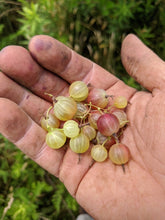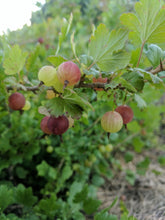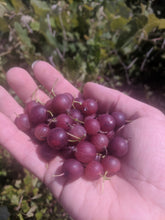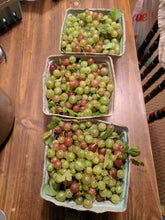'Captivator' Gooseberry
Regular price
$4.50
Sale
Ribes uva-crispa x Ribes hirtellum
Origin: Geneva, New York
Improvement status: Cultivar
Seeds per packet: ~25
BOTANICAL SAMPLE - NOT GERMINATION TESTED
Life cycle: Perennial
Developed in 1935, 'Captivator' is a hybrid between the common European gooseberry species (Ribes uva-crispa) and a wild American species (Ribes hirtellum). We're not sure which was the seed parent and which the pollen parent. Either way, the resulting plant — released by the Central Experimental Farm in Ottawa, Ontario in 1949 — is simply fantastic. It certainly captivates us throughout the many weeks in early-to-mid summer when it's simply loaded with fruit. The unripe green fruit, tart and crunchy, can be used for jams, jellies, pies, and wine, while the the ripe pink-to-burgundy fruit, sweet and soft, can be used for all of those purposes in addition to being enjoyed out of hand. Berries exposed to the sun ripen faster, so it's possible to find the last of the ripe fruit deep within the bushes many weeks after the first ripen. The long ripening period is helpful because picking gooseberries can be a slow process on account of the thorns.
It's not outlandish to assume that one 'Captivator' bush just a few years old will produce a quart or more of fruit. More mature bushes can produce four or five times that, and since gooseberries root so easily, its trailing branches become new plants when the tip hits the ground, so one bush can easily become a thicket within a few years if not maintained. Gooseberries are also easy to graft, so you can create a bush with loads of different types of berries on it (there are hundreds of gooseberry cultivars in existence). 'Captivator' is mildew and rust-resistant, has few insect pests that bother it (at least in our neck of the woods), and is incredibly cold-hardy, as its northern Ontario provenance suggests it should be.
Gooseberries are highly prized in Europe, but have been severely neglected in the US. This is in large part due to the longstanding prohibition on gooseberry cultivation (along with their close currant cousins) implemented by agricultural authorities because members of the Ribes genus are carriers of a fungal pathogen called White Pine Blister Rust (Cronartium ribicola). The lumber lobby got the government to force farmers to stop growing these plants to protect their lucrative industry, but ultimately federal and most state authorities realized the Ribes ban accomplished very little — since so many wild Ribes species exist across the continent already. But it's still worth checking your local rules before planting gooseberries, since some bans are unfortunately still in place.
Seeds of this species do not grow "true to type", so every seed you plant will have a unique combination of genes and have the potential to become a new named variety. If you produce any winners, we hope you'll share cuttings with us someday!
GROWING TIPS: The biggest challenge with gooseberries is germination. The seeds have some dormancy issues, so at least one cold-moist stratification period (3-4 months) is normally required. Alternatively, seeds can also be planted outdoors in the fall or early-mid winter to allow nature to take its course. The many changes in temperature they experience in the real world can help them break dormancy. We recommend trying both methods! Given the long stratification often necessary, we have not germination tested these seeds and so are selling them as botanical samples. But they are fresh, harvested and processed by Nate in 2024.










